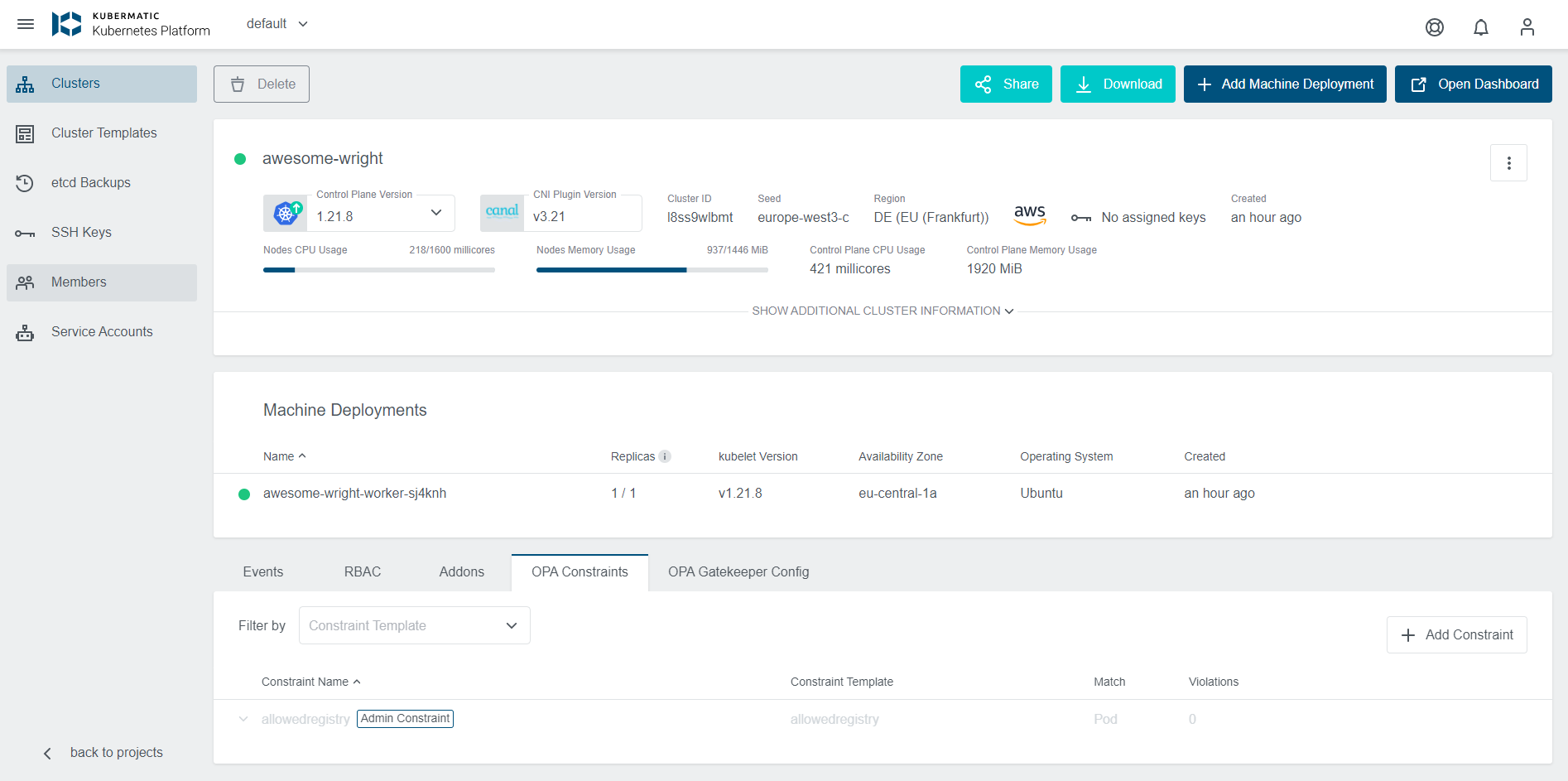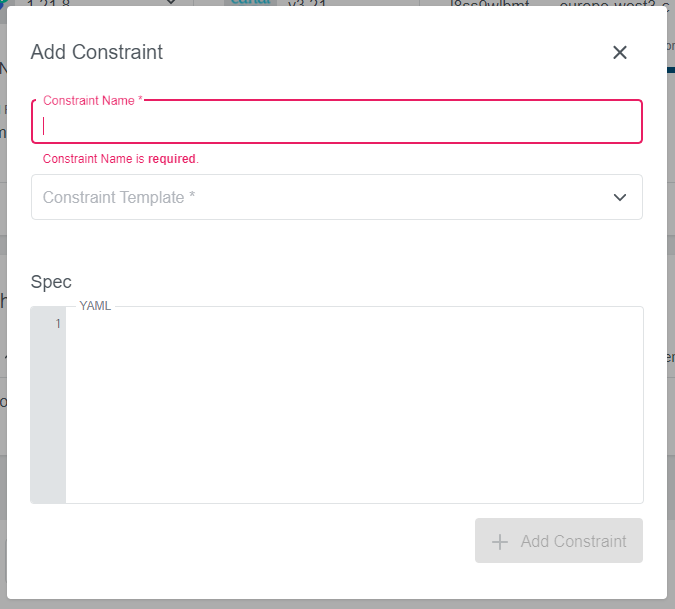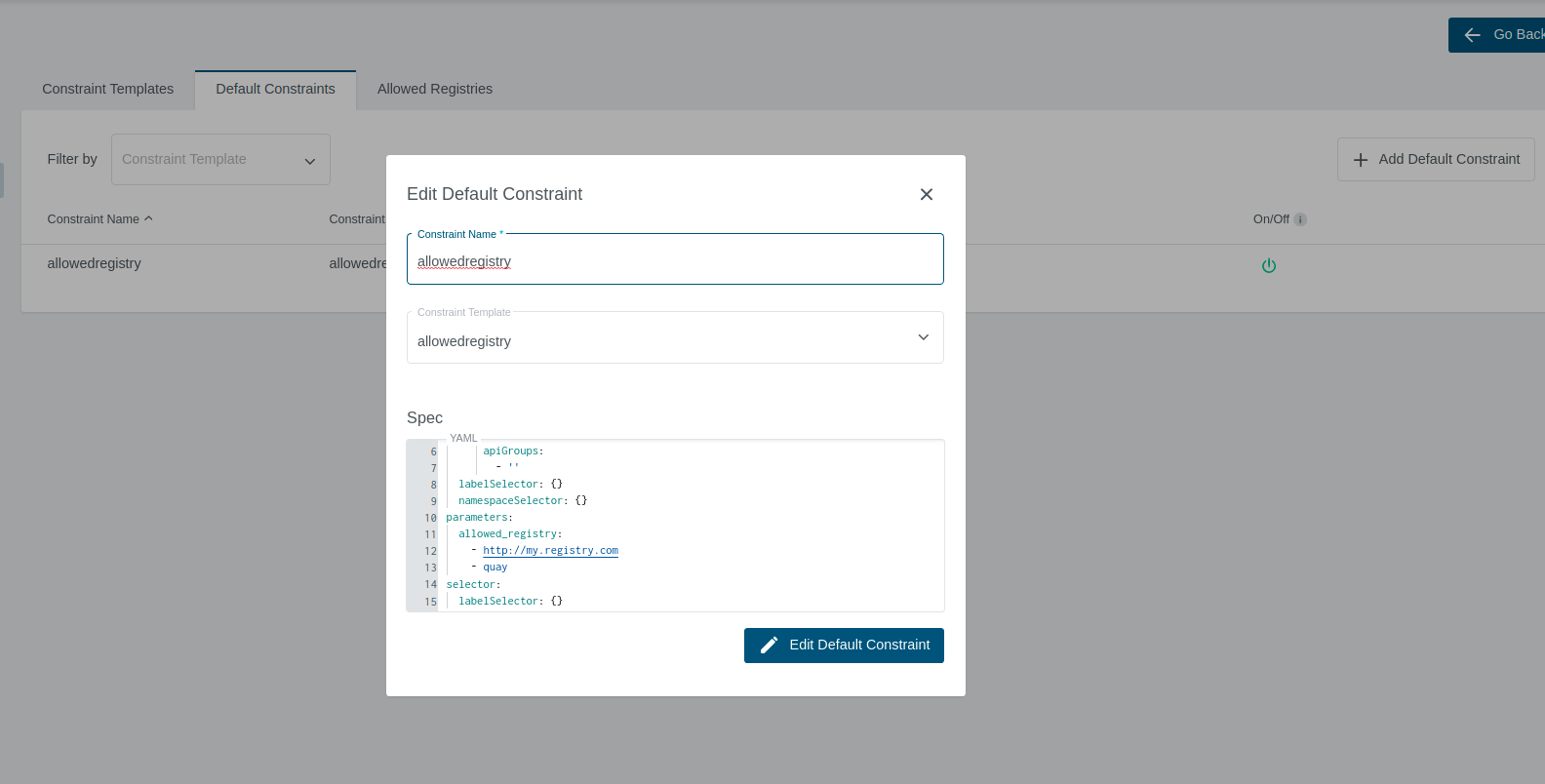This manual explains how Kubermatic integrates with OPA and how to use it.
OPA
OPA (Open Policy Agent) is an open-source, general-purpose policy engine that unifies policy enforcement across the stack. We are integrating with it using Gatekeeper, which is an OPA’s Kubernetes-native policy engine.
More info about OPA and Gatekeeper can be read from their docs and tutorials, but the general idea is that by using the Constraint Template CRD the users can create rule templates whose parameters are then filled out by the corresponding Constraints.
How to activate OPA Integration on your cluster
The integration is specific per user cluster, meaning that it is activated by a flag in the cluster spec.
apiVersion: kubermatic.k8c.io/v1
kind: Cluster
metadata:
name: l78dsl4l8x
spec:
humanReadableName: cocky-thompson
oidc: {}
opaIntegration:
enabled: true
pause: false
By setting this flag to true, Kubermatic automatically deploys the needed Gatekeeper components to the control plane as well as the user cluster.
Managing Constraint Templates
Constraint Templates are managed by the Kubermatic platform admins. Kubermatic introduces a Kubermatic Constraint Template wrapper CRD through which the users can interact with the OPA CT’s. The Kubermatic master clusters contain the Kubermatic CT’s which designated controllers to reconcile to the seed and to user cluster with activated OPA integration as Gatekeeper CT’s.
Example of a Kubermatic Constraint Template:
apiVersion: kubermatic.k8c.io/v1
kind: ConstraintTemplate
metadata:
name: k8srequiredlabels
spec:
crd:
spec:
names:
kind: K8sRequiredLabels
validation:
# Schema for the `parameters` field
openAPIV3Schema:
properties:
labels:
type: array
items:
type: string
targets:
- target: admission.k8s.gatekeeper.sh
rego: |
package k8srequiredlabels
violation[{"msg": msg, "details": {"missing_labels": missing}}] {
provided := {label | input.review.object.metadata.labels[label]}
required := {label | label := input.parameters.labels[_]}
missing := required - provided
count(missing) > 0
msg := sprintf("you must provide labels: %v", [missing])
}
Kubermatic Constraint Template corresponds 1:1 to the Gatekeeper Constraint Template.
Deleting Constraint Templates
Deleting Constraint Templates causes all related Constraints to be deleted as well.
Managing Constraints
Constraints are managed similarly to Constraint Templates through Kubermatic CRD wrappers around the Gatekeeper Constraints, the difference being that Constraints are managed on the user cluster level. Furthermore, due to the way Gatekeeper works, Constraints need to be associated with a Constraint Template.


To add a new constraint click on the + Add Constraint icon on the right at the bottom of cluster view. A new dialog will appear, where you can specify the name, the constraint template, and the spec:
Spec is the only field that needs to be filled with a yaml.

Note: You can now manage Default Constraints from the Admin Panel.
Kubermatic Constraint controller reconciles the Kubermatic Constraints on the seed clusters as Gatekeeper Constraints on the user cluster.
Example of a Kubermatic Constraint:
apiVersion: kubermatic.k8c.io/v1
kind: Constraint
metadata:
name: ns-must-have-gk
namespace: cluster-l78dsl4l8x
spec:
constraintType: K8sRequiredLabels
match:
kinds:
- apiGroups: [""]
kinds: ["Namespace"]
parameters:
labels: ["gatekeeper"]
constraintType- must be equal to the name of an existing Constraint Templatematch- works the same as Gatekeeper Constraint matchingparameters- holds the parameters that are used in Constraints. As in Gatekeeper, this can be basically anything that fits the related Constraint Template.
Default Constraints
Default Constraints allow admins to conveniently apply policies to all OPA enabled clusters. This would allow admins an easier way to make sure all user clusters are following some policies (for example security), instead of the current way in which Constraints need to be created for each cluster separately. Kubermatic operator/admin creates a Constraint in the admin panel, it gets propagated to seed clusters and user clusters with OPA-integration.
The following example is regarding Restricting escalation to root privileges in Pod Security Policy but implemented as Constraints and Constraint Templates with Gatekeeper.
Constraint Templates
crd:
spec:
names:
kind: K8sPSPAllowPrivilegeEscalationContainer
targets:
- target: admission.k8s.gatekeeper.sh
rego: |
package k8spspallowprivilegeescalationcontainer
violation[{"msg": msg, "details": {}}] {
c := input_containers[_]
input_allow_privilege_escalation(c)
msg := sprintf("Privilege escalation container is not allowed: %v", [c.name])
}
input_allow_privilege_escalation(c) {
not has_field(c, "securityContext")
}
input_allow_privilege_escalation(c) {
not c.securityContext.allowPrivilegeEscalation == false
}
input_containers[c] {
c := input.review.object.spec.containers[_]
}
input_containers[c] {
c := input.review.object.spec.initContainers[_]
}
# has_field returns whether an object has a field
has_field(object, field) = true {
object[field]
}
selector:
labelSelector: {}
Constraint
constraintType: K8sPSPAllowPrivilegeEscalationContainer
match:
kinds:
- kinds:
- Pod
apiGroups:
- ''
labelSelector: {}
namespaceSelector: {}
selector:
labelSelector: {}
Managing Default Constraints
Default Constraints are managed similarly to Constraint through Kubermatic CRD wrappers around the Gatekeeper Constraints, the difference being that Default Constraints are managed on the Admin level by Kubermatic platform admins.
Also Default Constraints are created in kubermatic namespace in Master Cluster from where they are propagated to seed clusters kubermatic namespace and then to user clusters with OPA-integration.
cluster namespaces
In the Admin Panel navigate to the OPA menu and then to Default Constraints.

To add a new default constraint click on the +Add Default Constraint icon on the right. A new dialog will appear, where you can specify the name, the constraint template and the spec:
Spec is the only field that needs to be filled with a yaml.

On Cluster Level, Default Constraints are the same as Constraints with a default label to differentiate them from other Constraints.
Note that they can not be edited/deleted at the Cluster level.
Example of a Kubermatic Default Constraint:
apiVersion: kubermatic.k8c.io/v1
kind: Constraint
metadata:
name: ns-must-have-gk
namespace: cluster-bpc9nstqvk
labels:
default: ns-must-have-gk
spec:
constraintType: K8sRequiredLabels
match:
kinds:
- apiGroups: [""]
kinds: ["Namespace"]
parameters:
labels: ["gatekeeper"]
Disabling Constraint
The constraint can be Disabled/Turned off by setting the disabled flag to true in the constraint spec.
To Enable Default Constraints again, you can just remove the disabled flag or set it to false.
This is an EE feature.
Example of a Disabled Kubermatic Constraint:
apiVersion: kubermatic.k8c.io/v1
kind: Constraint
metadata:
name: ns-must-have-gk
namespace: cluster-l78dsl4l8x
spec:
constraintType: K8sRequiredLabels
disabled: true
match:
kinds:
- apiGroups: [""]
kinds: ["Namespace"]
parameters:
labels: ["gatekeeper"]
Disabling Default Constraint
By setting disabled flag to true, Kubermatic deletes the constraint from all User clusters.
Note: Constraint will still be present in the user cluster namespace on the Seed Cluster for future use.
To Enable Default Constraints again, you can just remove the disabled flag or set it to false.
To disable Default Constraintsin the Admin View, click on the green button under On/Off

Enable the constraint by clicking the same button

Filtering Clusters on Default Constraints
Admins can filter clusters where they want Default constraints applied using Cloud Provider and Label Selectors filters.
This is an EE feature.
The following example will make sure that the Constraint is applied only on OPA enabled Clusters with Cloud Provider aws or gcp which have label filtered: 'true'.
constraintType: K8sRequiredLabels
match:
kinds:
- kinds:
- Namespace
apiGroups:
labelSelector: {}
namespaceSelector: {}
parameters:
labels: ["gatekeeper"]
selector:
providers:
- aws
- gcp
labelSelector:
matchLabels:
filtered: 'true'
Deleting Default Constraint
Deleting Default Constraint causes all related Constraints on the user clusters to be deleted as well.
Note: Cluster Admins will not be able to edit/delete Default Constraints
AllowedRegistry
AllowedRegistry allows admins to easily control what image registries can be used in user clusters. This is the first KKP inbuilt Constraint and its goal is to make creating Constraint Templates and Default Constraints simpler.
This is an EE feature.

AllowedRegistry functions as its own CR, which when created, triggers the creation of the corresponding
Constraint Template(allowedregistry) and Default Constraints(allowedregistry).
It accepts only 2 parameters, its name and the registry prefix of the registry which can be used on the user cluster.
When there are multiple AllowedRegistries, we collect all registry prefixes and put them into a list in the allowedregistry Default Constraint.
OPA matches these prefixes with the Pods container image field and if it matches with at least one, it allows the Pod to be created/updated.
They are cluster-scoped and reside in the KKP Master cluster.
Example of a AllowedRegistry:
apiVersion: kubermatic.k8c.io/v1
kind: AllowedRegistry
metadata:
name: quay
spec:
registryPrefix: quay.io
Corresponding ConstraintTemplate:
apiVersion: kubermatic.k8c.io/v1
kind: ConstraintTemplate
metadata:
name: allowedregistry
spec:
crd:
spec:
names:
kind: allowedregistry
validation:
openAPIV3Schema:
properties:
allowed_registry:
items:
type: string
type: array
selector:
labelSelector: {}
targets:
- rego: |-
package allowedregistry
violation[{"msg": msg}] {
container := input.review.object.spec.containers[_]
satisfied := [good | repo = input.parameters.allowed_registry[_] ; good = startswith(container.image, repo)]
not any(satisfied)
msg := sprintf("container <%v> has an invalid image registry <%v>, allowed image registries are %v", [container.name, container.image, input.parameters.allowed_registry])
}
violation[{"msg": msg}] {
container := input.review.object.spec.initContainers[_]
satisfied := [good | repo = input.parameters.allowed_registry[_] ; good = startswith(container.image, repo)]
not any(satisfied)
msg := sprintf("container <%v> has an invalid image registry <%v>, allowed image registries are %v", [container.name, container.image, input.parameters.allowed_registry])
}
target: admission.k8s.gatekeeper.sh
Corresponding Default Constraint:
apiVersion: kubermatic.k8c.io/v1
kind: Constraint
metadata:
name: allowedregistry
namespace: kubermatic
spec:
constraintType: allowedregistry
match:
kinds:
- apiGroups:
- ""
kinds:
- Pod
labelSelector: {}
namespaceSelector: {}
parameters:
allowed_registry:
- quay.io
selector:
labelSelector: {}

For the existing allowedregistry Default Constraint, feel free to edit the Filtering.
When a user tries to create a Pod with an image coming from a registry that is not prefixed by one of the AllowedRegistries, they will get a similar error:
container <unwanted> has an invalid image registry <unwanted.registry/unwanted>, allowed image registries are ["quay.io"]
A similar feature as AllowedRegistries can be achieved by an OPA-familiar user, using Constraint Templates and Default Constraints, AllowedRegistries are just a way to make admins life easier.
When there are no AllowedRegistries, we automatically disable the Default Constraint.
Managing Config
Gatekeeper Config can also be managed through Kubermatic. As Gatekeeper treats it as a kind of singleton CRD resource, Kubermatic just manages this resource directly on the user cluster.
You can manage the config in the user cluster view, per user cluster.
Removing OPA Integration
OPA integration on a user cluster can simply be removed by disabling the OPA Integration flag on the Cluster object. Be advised that this action removes all Constraint Templates, Constraints, and Config related to the cluster.
Exempting Namespaces
gatekeeper-system and kube-system namespace are by default entirely exempted from Gatekeeper webhook which means they are exempted from the Admission Webhook and Auditing.
More on this here Exempt-Namespace